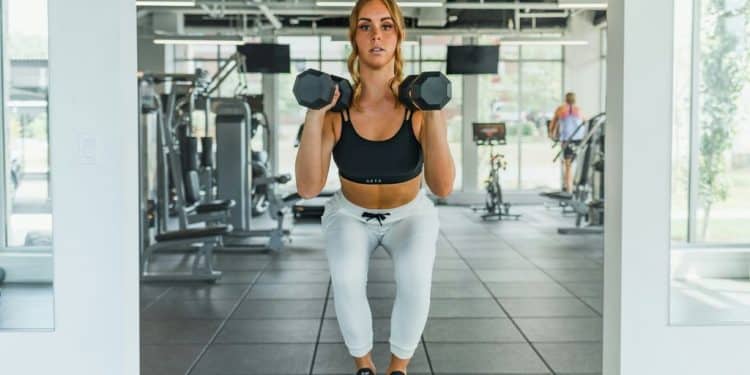Something has been bugging me (and probably you too) for ages: spot reduction. You know, the idea that you can do a million crunches and magically melt away belly fat? Or endless bicep curls to banish arm jiggle? Yeah, not so much. It’s time to ditch these fitness myths once and for all.
Why Targeted Fat Loss Is a Fitness Myth
Here’s the deal: your body doesn’t work that way. You can’t tell it where to burn fat from. When you lose fat, it comes off all over, not just from the area you’re working on. Think of it like this: your body is a team, not a collection of individual parts. You can’t just tell one player to score all the points. It’s a system!
Understanding How Your Body Burns Fat
Fat burning is a whole-body process. So don’t believe all those fitness myths out there, and just listen to what your body tells you. When you exercise, your body taps into its energy reserves, which includes fat. But it doesn’t discriminate. It pulls from wherever it needs to, based on genetics, hormones, and a bunch of other factors. So, while those leg lifts might strengthen your thighs, they won’t specifically target thigh fat.
Embracing Full-Body Workouts for Real Results
So, what’s the solution? Full-body workouts! These are way more effective for overall fat loss and building a balanced physique. Here’s why:
- They burn more calories. More muscles working = more energy expended.
- They boost your metabolism. Building muscle helps you burn more calories even when you’re resting.
- They’re more efficient. You’re working multiple muscle groups at once, saving you time.
Instead of focusing on endless reps of one exercise, try incorporating compound movements like squats, deadlifts, push-ups, and rows into your routine. Trust me, you’ll see way better results, and you’ll feel stronger and more energized too!
The Truth About Cardio and Weightlifting
Cardio Isn’t the Only Path to Fitness
For years, cardio has been hailed as the king of fitness, especially when it comes to shedding pounds. But guess what. This is one of those fitness myths too. It’s not the only way to get fit! While activities like running, swimming, and cycling are fantastic for your heart and endurance, they’re not the be-all and end-all. Think of cardio as one tool in your fitness toolbox, not the entire set. There are so many other ways to get your body moving and grooving, and many of them offer benefits that cardio alone simply can’t provide. Don’t get me wrong, consistent cardio exercise is great, but let’s explore some alternatives!
Why Lifting Weights Won’t Make You Bulky
One of the biggest misconceptions out there is that lifting weights will automatically turn you into a bodybuilder. This is especially concerning for women, who often worry about becoming “too muscular.” But here’s the truth: building significant muscle mass takes a lot of time, dedication, and a specific diet. It’s not something that happens overnight, or even over a few months. Plus, women have lower levels of testosterone than men, making it even harder to bulk up. So, unless you’re actively trying to pack on muscle, lifting weights will more likely leave you toned and strong, not bulky. Here’s why you should consider weightlifting:
- Increased strength and endurance
- Improved bone density
- Boosted metabolism
The Power of Combining Cardio and Strength Training
Okay, so we’ve established that both cardio and weightlifting have their own unique benefits. But what happens when you combine them? Magic! Combining cardio and strength training is like creating the ultimate fitness dream team. You get the cardiovascular benefits of cardio, like improved heart health and endurance, along with the strength, muscle tone, and metabolic boost of weightlifting. It’s a win-win! Here’s a simple way to think about it:
- Start with a warm-up to get your body ready.
- Do some strength training exercises, focusing on different muscle groups.
- Follow it up with a cardio session, whether it’s running, cycling, or swimming.
- Finish with a cool-down and some stretching.
By incorporating both cardio and strength training into your routine, you’ll be well on your way to a healthier, fitter, and more balanced you!
Fueling Your Body: Beyond the Basics

Debunking the ‘No Pain, No Gain’ Mentality
Okay, let’s be real. That whole “no pain, no gain” thing? It’s kinda outdated. Pushing yourself to the point of injury isn’t some badge of honor; it’s just, well, dumb. It’s way more important to listen to your body and understand its limits. I remember one time I went way too hard on leg day, and I could barely walk for a week. Not fun! Instead of aiming for excruciating pain, focus on these:
- Progressive overload: Gradually increasing the intensity of your workouts over time.
- Proper form: Making sure you’re doing exercises correctly to avoid injury.
- Mindful movement: Paying attention to how your body feels during exercise.
The Importance of Rest and Recovery
Seriously, rest is NOT for the weak. It’s when your muscles actually repair and get stronger. Think of it like this: you wouldn’t expect your phone to work if you never charged it, right? Your body is the same way! Sleep is your best friendsleep is your best friend, and I try to get at least 7-8 hours every night. Here’s what I’ve found helps:
- Prioritize sleep: Make it a non-negotiable part of your routine.
- Active recovery: Gentle activities like walking or stretching can help reduce muscle soreness.
- Listen to your body: If you’re feeling exhausted, take a day off!
Smart Nutrition for Sustainable Progress
Eating right isn’t about deprivation; it’s about fueling your body with what it needs to thrive. I used to think I could eat whatever I wanted as long as I exercised, but Dr. Tamara Alireza is right, you can’t out-exercise a bad diet. Focus on whole, unprocessed foods that give you energy and support your fitness goals. Here are some things I try to keep in mind:
- Balance your macros: Get enough protein, carbs, and healthy fats.
- Don’t skip meals: Regular meals help keep your energy levels stable.
- Hydrate, hydrate, hydrate: Water is essential for everything from muscle function to digestion. I’ve been using Beyond Macros to track my nutritional intake and it’s been a game changer!
Rethinking Your Workout Schedule
There’s No Single ‘Best Time’ to Exercise
Okay, let’s ditch the idea that there’s some magical hour to hit the gym. Seriously, the “best time” is whenever you can realistically make it happen! Some people swear by early morning workouts to kickstart their day, while others are night owls who prefer to sweat it out after work. The key is finding what works for your body and schedule. Don’t force yourself into a routine that feels like a chore. Listen to your body clock and experiment to see when you feel most energized and motivated.
Finding a Routine That Fits Your Life
Life’s hectic, right? So, your workout routine needs to fit into your life, not the other way around. Here’s how to make it happen:
- Be realistic: Don’t commit to seven days a week if you know you’ll burn out. Start small and build up gradually.
- Schedule it: Treat your workouts like important appointments. Put them in your calendar and stick to them as much as possible.
- Find activities you enjoy: If you hate running, don’t run! Explore different types of exercise until you find something you genuinely like. Maybe it’s swimming, dancing, hiking, or even strength training. The more you enjoy it, the more likely you are to stick with it.
Consistency Trumps Intensity Every Time
This is one of the biggest fitness myths. You don’t need to kill yourself every workout to see results. In fact, consistent, moderate effort is often more effective than sporadic bursts of intense training. Think of it like this:
- Small steps add up: A 30-minute walk every day is better than a three-hour gym session once a month.
- Avoid burnout: Pushing yourself too hard too often can lead to fatigue, injuries, and a loss of motivation.
- Make it a habit: Focus on building a sustainable routine that you can maintain long-term. It’s all about making movement a regular part of your life. Remember, even a little bit of overall activity levels is better than none!
Fitness myths: Unpacking the 10,000 Steps

Why 10,000 Steps Isn’t a Magic Number
Now the 10,000 steps thing. It’s everywhere, right? But do you know its one of the biggest fitness myths? Your fitness tracker probably yells at you if you don’t hit it. But here’s the deal: it’s kind of arbitrary. Turns out, the whole 10,000 steps idea started with a Japanese pedometer back in the ’60s. It wasn’t really based on solid science, but more of a marketing thing. That doesn’t mean walking isn’t good for you, just that there’s no magical significance to that specific number. Some studies show benefits at way less than 10,000, like around 7,000 or even 4,400 steps a day!
Focusing on Overall Activity Levels
Instead of obsessing over a number, think about your overall activity. Are you mostly sitting all day? Then yeah, getting more steps is a great idea. But if you’re already active, don’t stress about hitting that 10,000 mark. Think about it this way:
- Do you feel good and energized?
- Are you incorporating different types of movement into your day?
- Are you challenging yourself (without overdoing it)?
If the answer is yes, you’re probably doing just fine. It’s about finding what works for you and your body. Maybe you prefer swimming, cycling, or dancing. All of that counts!
Making Movement a Joyful Part of Your Day
Honestly, the best kind of exercise is the kind you actually enjoy. If you dread walking just to hit a number, you’re less likely to stick with it. So, find activities that make you happy. Walk with a friend, explore a new park, put on some music and dance around your living room. Make it fun, and you’ll be way more likely to keep moving. Remember:
- Find activities you genuinely like.
- Incorporate movement into your daily routine naturally.
- Don’t treat exercise as a chore, but as a way to feel good and improve heart health.
The Real Deal About Muscle Soreness

Soreness Doesn’t Always Equal a Good Workout
Let’s get real. That burning sensation after a workout? It doesn’t always mean you crushed it. Sometimes, it just means you did something your body wasn’t used to. Chasing soreness can actually lead to overtraining and injury, which is the opposite of what we’re going for. It’s more important to focus on proper form and consistent effort than trying to feel like you got hit by a truck after every session.
Listening to Your Body’s Signals
Your body is pretty good at telling you what it needs, if you actually listen. Ignoring those little aches and pains can turn them into big problems down the road. Pay attention to the difference between normal muscle fatigue and sharp, stabbing pain. If something feels off, don’t push through it! Here’s what to keep in mind:
- Pain vs. Soreness: Soreness is usually a dull ache that fades over time. Pain is sharp, persistent, and might indicate an injury.
- Range of Motion: Can you move freely, or is something restricted? Limited range of motion can be a sign of inflammation or strain.
- Resting Heart Rate: Is your resting heart rate elevated for several days after a workout? That could mean your body is still in recovery mode.
Prioritizing Proper Form Over Extreme Effort
I cannot stress this enough: good form is king (or queen!). It’s way better to do fewer reps with perfect form than a bunch of sloppy ones that could hurt you. Think about it this way:
- Engage the Right Muscles: Proper form ensures you’re working the muscles you intend to work.
- Reduce Injury Risk: Good form minimizes stress on your joints and connective tissues.
- Maximize Efficiency: When you’re using the right form, you’re getting the most out of every rep. If you are unsure, seek advice from a
- personal trainer before lifting weights.
We’ve gone through some of the biggest fitness myths out there, the ones that have been hanging around for way too long. It’s pretty wild how much bad info is still floating around, right? But now you know better. Forget those old ideas about what you “should” be doing. The real deal is about finding what works for you, what makes you feel good, and what you can stick with. No more stressing about perfect routines or magic fixes. Just get out there, move your body, and enjoy the process. Your fitness journey is yours alone, so make it awesome!
Do you want more information on everything related to fitness? Then visit our complete fitness category here!





